3-D has been the biggest thing to happen to movies since the introduction of color. Now, you and your family can enjoy the 3-D experience at home with 3-D-ready TV sets that can operate in both 3-D mode with active shutter glasses as well as normal 2-D mode.
To help you with the task of determining which television has the best 3-D and picture quality, the Good Housekeeping Research Institute tested 3-D TVs with plasma, LCD, and rear-projection screens. Here, the results of the test:
Pros:
• Very good picture in high definition, standard definition and 3-D for both dark and bright scenes.
• Because it's plasma, it displays the same picture at all viewing angles. Many LCD TVs have viewing angle issues.
• Sound clarity was among the highest tested, and its sound level was good as well.
• The remote, menus, changing between inputs, and additional features were all easy to use.
• The television was effortless to setup the 3-D; all you need to do it put on the glasses and hit a single button on the remote to toggle between 3-D and 2-D.
• Consumers felt the glasses were comfortable.
• The price point of this television is appealing.
• Able to convert any 2-D content into 3-D. Blu-Ray movies, DVDs, still images, home movies, and broadcast content can all be converted from 2-D to 3-D with the touch of a button.
Cons:
• Required some adjustment of brightness and color; a 51.7 percent increase and 20 percent decrease, respectively.
• Because it is plasma, there may be an issue of burn in after prolonged viewing of a static image on the screen.
Pros:
• During our testing, the LG received near-perfect scores for high definition, standard definition and 3-D for both dark and bright scenes, with scores of 4.5 out of 5 in nearly all categories.
• The LG required little adjustment of brightness (a 14 percent increase) and no adjustment of contrast or color when placed in ISF mode. This mode provided the most accurate picture settings prior to our calibrations and was developed with the assistance of the Imaging Science Foundation, which establishes standards and methodologies for the video and home theater industry.
• There was not much change in picture quality when viewing at different angles.
• Sound clarity and level were both good.
• Ranked easiest television to use, based on our ease of use testing.
• Effortless to setup the 3-D; all you need to do it put on the glasses and hit a single button on the remote to toggle between 3-D and 2-D.
• Consumers rated it very highly for 3-D quality.
• Lab tests rated the 3-D quality as excellent.
• The layout and the graphics of the menus are very appealing and easy to use.
• The LG 3-D glasses are able to charge via USB, which means no need to worry about replacing dead batteries in your 3D glasses.
Con:
• Expensive
Pros:
• Scored good picture quality for high definition, standard definition and 3-D for both dark and bright scenes.
• Picture quality did not change at all with viewing angle.
• The remote, menus, changing between inputs, and additional features all scored easy to use.
• The television was effortless to setup the 3-D; all you need to do it put on the glasses and hit a single button on the remote to toggle between 3-D and 2D.
• Cheaper than most 3-D LCD TVs .
Cons:
• In terms of calibration, the Panasonic required a 48.3 percent decrease in contrast, 78.6 percent increase in brightness, and a 10 percent decrease in color.
• The VT25 scored low for sound level but scored highly in sound clarity.
• Consumers felt the glasses were uncomfortable to wear.
Pros:
• Good picture quality for high definition, standard definition and 3-D for both dark and bright scenes.
• In terms of calibration, the Sony required only a 5.6 percent decrease in contrast, 30 percent increase in brightness, and a 4 percent decrease in color.
• Scored highly for sound level and clarity.
• The remote, menus, changing between inputs and additional features all are easy to use.
• The glasses have good coverage around the sides of your head and prevented peripheral distractions.
Cons:
• Consumers didn't like the fact that when you turned your head slightly, the 3-D image vanished.
• The television did require a lot of effort to setup the 3-D. Many of the televisions tested had a built in 3-D emitter, but the Sony is equipped with an external infrared emitter that needs to be plugged into the back of the television and mounted with double-sided tape to the table or top of television. This emitter is needed in order for the glasses to receive the right signals from the television so they can know when and how to produce the 3D image.
• The picture quality of the Sony was affected by off-center viewing angles.
• The remote and additional features weren't all that easy to use.
Pros:
• The sound level of the television scored very highly.
• The menus, inputs, and additional features were somewhat easy to use.
• Consumers felt the glasses were among the most comfortable.
Cons:
• Required a ton of picture adjustment right out of the box.
• Its viewing angle affected the picture quality greatly.
• 3-D setup was cumbersome because it required the addition of a 3-D Kit which includes a 3-D emitter and receiver (similar to connecting a satellite receiver or cable box).
• The sound clarity was mediocre.
• High definition picture quality
• Standard definition picture quality
• 3-D picture quality
• Evaluation of black levels, white levels, and color levels
• Performance of the 3-D glasses
• Video resolution and film resolution, which differ in how much adjustment the television must make in order to produce a good quality picture.
• Sound level and sound clarity
• Ease of setup and comfort of the 3-D glasses
• Ease of using the remote control
• Ease of navigating the menus and settings
• Additional features ease of use
How We Tested:
• Using calibration software, we calibrated black levels, white levels, and color. We then compared them to factory settings and determined how much adjustment the televisions would require when you set it up at home.
• We used test patterns to evaluate the performance of the video processors of each television for both video resolution loss and film resolution loss.
• Once each of the settings were calibrated, we assessed the picture quality of both high definition content and standard definition content for dark scenes and bright scenes using various Blu-Ray Discs and DVDs.
• Using 3-D Bluray discs we evaluated the quality of the 3-D content of both dark scenes and bright scenes.
• Each television was viewed from various viewing angles to determine how much the picture quality was affected, simulating a person sitting to the far left or right of the television.
• GHRI inspected the glasses and evaluated the performance of the active shutter glasses while watching 3-D content.
• We measured the highest sound level the television was able to produce and determined the level of sound clarity at that level.
• We evaluated the ease of use of the remote control as well as the navigation of menus and setting. We also rated the ease of switching between inputs to determine how easy it would be to switch from your cable/satellite source to a DVD player.
• We evaluated many of the additional features of the televisions, such as picture-in-picture, internet connectivity, closed captioning and determined how easy and appealing they were to use.
• Testers tried on and evaluated the comfort of the 3-D glasses as well as the 3-D quality while they watched 3-D content.
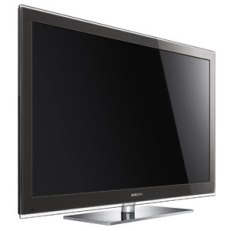 |
| Samsung 50" PN50C8000 Photo Courtesy of Samsung |
Samsung 50" PN50C8000
This Samsung 50" Plasma 3-D TV produces very good picture in 3-D, as well as in high definition and standard definition 2-D. Using this 3-D set was effortless, and our testers felt the glasses were comfortable, light, and easy to use. One of the most exciting features is that it's able to convert any 2-D content into 3-D. Just watch out for image burn-in while watching programs with a static image on the screen, like a video game menu bar or a channel logo, for extended hours. Switch channels to avoid logo burn in and limit the number of hours video games are played. Starting at $1658, Yahoo! Shopping.Pros:
• Very good picture in high definition, standard definition and 3-D for both dark and bright scenes.
• Because it's plasma, it displays the same picture at all viewing angles. Many LCD TVs have viewing angle issues.
• Sound clarity was among the highest tested, and its sound level was good as well.
• The remote, menus, changing between inputs, and additional features were all easy to use.
• The television was effortless to setup the 3-D; all you need to do it put on the glasses and hit a single button on the remote to toggle between 3-D and 2-D.
• Consumers felt the glasses were comfortable.
• The price point of this television is appealing.
• Able to convert any 2-D content into 3-D. Blu-Ray movies, DVDs, still images, home movies, and broadcast content can all be converted from 2-D to 3-D with the touch of a button.
Cons:
• Required some adjustment of brightness and color; a 51.7 percent increase and 20 percent decrease, respectively.
• Because it is plasma, there may be an issue of burn in after prolonged viewing of a static image on the screen.
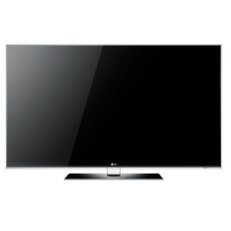 |
| LG 47" 47LX9500 Photo Courtesy of LG |
LG 47" 47LX9500
The LX9500 47" 3-D LCD TV received high scores for 3-D picture quality, high definition, and standard definition content. Our testers gave this television the highest score for 3-D quality, and our evaluations revealed it to be extremely easy to use. Starting at $1729, Yahoo! Shopping.Pros:
• During our testing, the LG received near-perfect scores for high definition, standard definition and 3-D for both dark and bright scenes, with scores of 4.5 out of 5 in nearly all categories.
• The LG required little adjustment of brightness (a 14 percent increase) and no adjustment of contrast or color when placed in ISF mode. This mode provided the most accurate picture settings prior to our calibrations and was developed with the assistance of the Imaging Science Foundation, which establishes standards and methodologies for the video and home theater industry.
• There was not much change in picture quality when viewing at different angles.
• Sound clarity and level were both good.
• Ranked easiest television to use, based on our ease of use testing.
• Effortless to setup the 3-D; all you need to do it put on the glasses and hit a single button on the remote to toggle between 3-D and 2-D.
• Consumers rated it very highly for 3-D quality.
• Lab tests rated the 3-D quality as excellent.
• The layout and the graphics of the menus are very appealing and easy to use.
• The LG 3-D glasses are able to charge via USB, which means no need to worry about replacing dead batteries in your 3D glasses.
Con:
• Expensive
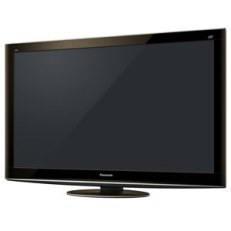 |
| Panasonic 50" TC-P50VT25 Photo Courtesy of Panasonic |
Panasonic 50" TC-P50VT25
The VT25 Plasma 50" 3-D TV earned a good picture quality score for 3-D, high definition and standard definition. Since it's plasma, viewing angle is not an issue with this television. Setting up to watch 3-D content is effortless — simply hit the 3-D button on the remote and put on the active shutter glasses. However, our testers felt the 3-D glasses were uncomfortable and rested awkwardly on their noses, due to the adjustable rubber nose piece, which tended to fall off easily. Watch out for image burn-in while watching programs with a static image on the screen, like a video game menu bar or a channel logo, for extended hours. Switch channels to avoid logo burn in and limit the number of hours video games are played. About $2600, panasonic.com .Pros:
• Scored good picture quality for high definition, standard definition and 3-D for both dark and bright scenes.
• Picture quality did not change at all with viewing angle.
• The remote, menus, changing between inputs, and additional features all scored easy to use.
• The television was effortless to setup the 3-D; all you need to do it put on the glasses and hit a single button on the remote to toggle between 3-D and 2D.
• Cheaper than most 3-D LCD TVs .
Cons:
• In terms of calibration, the Panasonic required a 48.3 percent decrease in contrast, 78.6 percent increase in brightness, and a 10 percent decrease in color.
• The VT25 scored low for sound level but scored highly in sound clarity.
• Consumers felt the glasses were uncomfortable to wear.
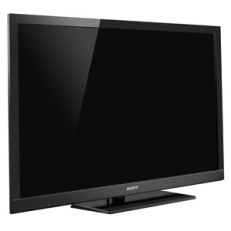 |
| Sony Bravia 55" 55HX800 Photo Courtesy of Sony |
Sony Bravia 55" 55HX800
The Sony Bravia 55" HX800 3-D LCD TV produces good picture quality in high definition, standard definition, and 3-D. During 3-D quality testing, testers found that the 3-D image disappeared when they tilted their heads slightly off-center, but when they remained straight, the 3-D quality was great. Starting at $1779, Yahoo! Shopping.Pros:
• Good picture quality for high definition, standard definition and 3-D for both dark and bright scenes.
• In terms of calibration, the Sony required only a 5.6 percent decrease in contrast, 30 percent increase in brightness, and a 4 percent decrease in color.
• Scored highly for sound level and clarity.
• The remote, menus, changing between inputs and additional features all are easy to use.
• The glasses have good coverage around the sides of your head and prevented peripheral distractions.
Cons:
• Consumers didn't like the fact that when you turned your head slightly, the 3-D image vanished.
• The television did require a lot of effort to setup the 3-D. Many of the televisions tested had a built in 3-D emitter, but the Sony is equipped with an external infrared emitter that needs to be plugged into the back of the television and mounted with double-sided tape to the table or top of television. This emitter is needed in order for the glasses to receive the right signals from the television so they can know when and how to produce the 3D image.
• The picture quality of the Sony was affected by off-center viewing angles.
• The remote and additional features weren't all that easy to use.
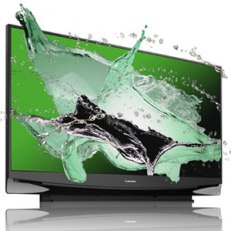 |
| Mitsubishi 3D Home Cinema TV WD-60738 Photo Courtesy of Mitsubishi |
Mitsubishi 60" 3D Home Cinema TV WD-60738
This 60" television is a rear-projection DLP type, and with the addition of the 3-D Kit, it's able to display 3-D content. But the picture quality for high definition, standard definition and 3-D images are mediocre when compared to the plasma and LCD televisions. Rear-projection televisions are prone to poor brightness levels and narrow viewing angles, and this was no exception. Testers felt the glasses were comfortable but did not think the 3-D quality was outstanding. Starting at $1095, Yahoo! Shopping.Pros:
• The sound level of the television scored very highly.
• The menus, inputs, and additional features were somewhat easy to use.
• Consumers felt the glasses were among the most comfortable.
Cons:
• Required a ton of picture adjustment right out of the box.
• Its viewing angle affected the picture quality greatly.
• 3-D setup was cumbersome because it required the addition of a 3-D Kit which includes a 3-D emitter and receiver (similar to connecting a satellite receiver or cable box).
• The sound clarity was mediocre.
3-D Televisions: How We Tested
The Good Housekeeping Research Institute evaluated 3-D televisions for:• High definition picture quality
• Standard definition picture quality
• 3-D picture quality
• Evaluation of black levels, white levels, and color levels
• Performance of the 3-D glasses
• Video resolution and film resolution, which differ in how much adjustment the television must make in order to produce a good quality picture.
• Sound level and sound clarity
• Ease of setup and comfort of the 3-D glasses
• Ease of using the remote control
• Ease of navigating the menus and settings
• Additional features ease of use
How We Tested:
• Using calibration software, we calibrated black levels, white levels, and color. We then compared them to factory settings and determined how much adjustment the televisions would require when you set it up at home.
• We used test patterns to evaluate the performance of the video processors of each television for both video resolution loss and film resolution loss.
• Once each of the settings were calibrated, we assessed the picture quality of both high definition content and standard definition content for dark scenes and bright scenes using various Blu-Ray Discs and DVDs.
• Using 3-D Bluray discs we evaluated the quality of the 3-D content of both dark scenes and bright scenes.
• Each television was viewed from various viewing angles to determine how much the picture quality was affected, simulating a person sitting to the far left or right of the television.
• GHRI inspected the glasses and evaluated the performance of the active shutter glasses while watching 3-D content.
• We measured the highest sound level the television was able to produce and determined the level of sound clarity at that level.
• We evaluated the ease of use of the remote control as well as the navigation of menus and setting. We also rated the ease of switching between inputs to determine how easy it would be to switch from your cable/satellite source to a DVD player.
• We evaluated many of the additional features of the televisions, such as picture-in-picture, internet connectivity, closed captioning and determined how easy and appealing they were to use.
• Testers tried on and evaluated the comfort of the 3-D glasses as well as the 3-D quality while they watched 3-D content.
No comments:
Post a Comment